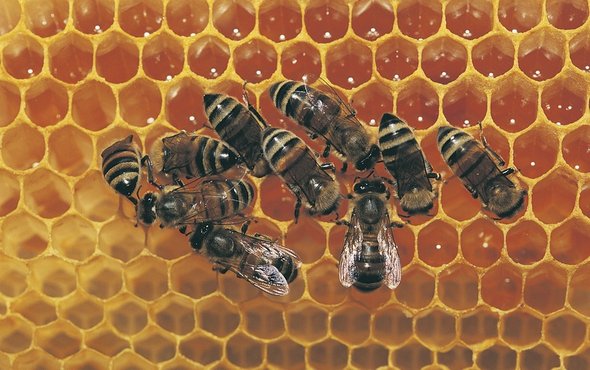(单词翻译:单击)
听力文本
This is Scientific American — 60-Second Science. I'm Jason G. Goldman.
Honeybees. They have a difficult task. First, they have to find food. Then they have to return to the hive to tell their compatriots where to find it. The bees have to fly back and forth between the hive and their food, over and over again. And they need to deal with whatever obstacles lie along their flight paths.
"Honeybees face a lot of challenge in choosing efficient foraging routes through dense environments. And we basically want to study how they choose effective routes...the safest and least energy-expending routes."
Marielle Ong, a researcher at the University of Queensland in Australia. To track the insects' navigation, she and her team set up tiny obstacle courses for more than a hundred honeybees.
Along the way, the bees were forced to fly through one or the other of two openings of different sizes. And as a group, the bees usually flew through the wider opening, which makes sense. Less chances of slamming their tiny bee bodies into a wall.
But things got more interesting when Ong looked at the decisions made by individual bees, one by one.
"We found that 55 percent had no biases, and the rest of the 45 percent was a split between left-handed bees and right-handed bees."

In other words, some honeybees have a sidedness. They obviously don't have hands, but let's say they're either right-handed or left-handed. So, for example, a right-handed bee would prefer to navigate the cramped right-side opening in the obstacle than go through the left-side hole, even though it was larger and safer. Sometimes, the handed bees would even land and walk through the smaller opening, just so they could use their preferred side.
These biases apparently help the members of large swarms navigate through a complex environment without crashing into each other. If all bees were right handed, it would take a long time for the entire group to pass through a small opening, such as a hive entrance. But by having a range of side biases, the entire swarm can move more quickly when it encounters an obstacle.
The research is in the journal PLOS One.
Ong thinks that one day engineers could apply this finding. They could design robotic drone swarms to negotiate obstacles more efficiently. They could even program self-driving cars to operate less like a chaotic assortment of humans and more like....an orderly group of honeybees.
Thanks for listening for Scientific American — 60-Second Science. I'm Jason G. Goldman.
参考译文
这里是科学美国人——60秒科学。我是杰森·古德曼。
蜜蜂,身负艰巨的任务。首先,它们要寻找食物。然后得返回蜂巢,告诉同伴去哪里觅食。蜜蜂不得不一次又一次地往返于蜂巢和食物之间。同时它们还得处理飞行路线上的所有障碍物。
“蜜蜂从密集环境中选择高效觅食路线时面临很多挑战。我们主要想研究它们如何选择高效路线,即如何选择最安全且能量消耗最低的路线。”
澳大利亚昆士兰大学的研究员Marielle Ong说道。为了追踪蜜蜂的飞行路线,她和团队在100多只蜜蜂的飞行路线上设置了小型障碍。
途中有两个不同大小的开口,蜜蜂必须从其中一个飞过。蜜蜂在集体行动时,通常会从较宽的开口飞过,这合情合理。这样是为了减少它们的小身躯撞到墙的几率。
但是当Ong观察单只蜜蜂逐个做决定时,情况变得更有趣了。
“我们发现55%的蜜蜂没有偏好,但是其余45%的蜜蜂分为左撇子蜜蜂和右撇子蜜蜂。”
换而言之,一些蜜蜂有偏向性。显然蜜蜂并没有手,但我们还是姑且称它们是左撇子或右撇子吧。例如,右撇子蜜蜂更愿意从障碍物右边的狭窄洞口飞过,而不是从左边飞过,即使左边的洞口更大更安全。有时,有偏向性的蜜蜂甚至会落在或穿过较小的洞口,只为了能使用它们偏爱的那一边。
这些偏好显然会帮助大蜂群中的蜜蜂在复杂环境中飞行,而又不会彼此碰撞。如果所有蜜蜂都是右撇子,那整个蜂群穿过蜂巢那种小开口会花费很长时间。但是,因为方向偏好不同,整个蜂群在遇到障碍时可以更迅速地移动。
这项研究结果发表在《公共科学图书馆·综合》期刊上。
Ong认为,工程师未来能应用这一发现。他们可以设计机器人无人机群,来更有效地通过障碍。他们甚至可以为自动驾驶汽车编程,使其运行起来更像是有秩序的蜂群,而不是杂乱的人群。
谢谢大家收听科学美国人——60秒科学。我是杰森·古德曼。
译文为可可英语翻译,未经授权请勿转载!
重点讲解
重点讲解:
1. back and forth 来回;往返;
例句:I could see the branches of the trees moving back and forth.
我能看到树枝来回摇摆。
2. over and over again 一再;再三;反复;
例句:This is what she has been saying over and over again--I don't know how many times.
这种话,她翻来覆去不知说过多少遍了。
3. make sense 可以理解;讲得通;
例句:It all makes sense now.
现在就都讲得通了。
4. one by one 逐个地;依次地;
例句:The students entered the classroom one by one.
学生们一个挨一个地走进教室。
5. in other words 换言之;换句话说;也就是说;
例句:In other words, we have to build different corporate cultures and ways of working.
换句话说,我们必须建立不同的企业文化和运作方式。


